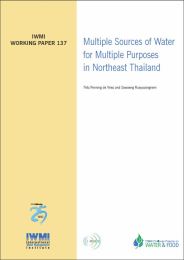Multiple sources of water for multiple purposes in Northeast Thailand.
Citation:
Penning de Vries, F.; Ruaysoongnern, S. 2010. Multiple sources of water for multiple purposes in Northeast Thailand. Colombo, Sri Lanka: International Water Management Institute. 37p. (IWMI Working Paper 137). [doi:10.3910/2010.208]
Abstract
Many farms in tropical countries suffer from droughts in the dry season and sometimes even in the rainy season. In order to significantly increase the capacity to store water, the grassroots Farmer Wisdom movement in Northeast Thailand innovated pond construction on homesteads. This Working Paper first documents how pond water is mainly used to irrigate crops and fruit trees, and is also used for livestock or fish, and for domestic uses, even if ample piped water is available. Households were also found to harvest rainwater from roofs; take water from canals and streams; lift water manually from shallow wells and with electric pumps from deep wells; channel run-off from roads to paddy fields; use precipitation as green water on fields; and buy bottled water. Most households combine at least six of these nine water sources. The second part describes scenarios and some outcomes of a new simulation model, BoNam. This model provides guidelines for the optimal size and site of such ponds according to biophysical factors (weather, soil and crops), socioeconomic factors (prices, availability of labor and off-farm income) and household aspirations.
ISBN 978-92-9090-725-1


